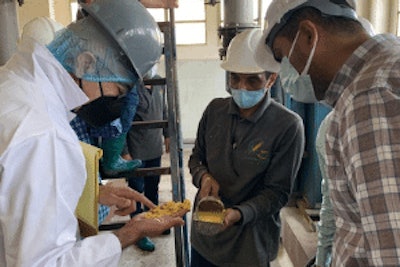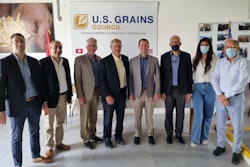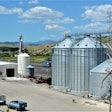
Most businesses have a desire to be more efficient with their inputs and increase profitability. To help one of the most renowned companies in Egypt improve its industrial starch plants’ operations, the U.S. Grains Council (USGC) connected the Cairo- based company with high-level starch consultant, Dr. Vijay Singh of the University of Illinois.
”辛格博士咨询始于2019年,他帮助ed the starch producers evaluate their facilities and identify processes that could improve their overall operations and plant profitability,” says Kyle Gilliam, USGC manager of global strategies and trade.
“The results of USGC’s industrial corn starch study were shared with the starch company via a virtual conference last year. The findings showed that U.S. corn can extract three to four percent higher yields of starch versus corn of other origins, which can have a significant impact on the plant’s overall profitability.”
This week, Dr. Singh and Gilliam traveled to Cairo to help the Egyptian starch company understand the technology and science associated with corn wet milling through an audit that analyzed the starch extractability of U.S.-origin corn. The study’s results show that starch companies processing 1,500 metric tons per day of corn can gain about $1 million in additional profit for every one percent of increase in starch yield. But to reach that gain, technology must be optimized.
Through one-on-one meetings and tours of the facilities, Dr. Singh was able to review the company’s procedures, collect samples and provide specific recommendations for improving its wet milling operations. Optimization of the wet milling process also allows for the discussion of U.S. corn benefits.
“Dr. Singh’s technical expertise helps provide reassurance that U.S. corn and co-products are an available and reliable source in Egypt,” Gilliam says. “We are working to continue to build long-term trust in this competitive market.”
Increasing use of starch by Egyptian customers could mean additional sales of U.S. corn – both for starch and other purposes.
U.S. corn exports to North Africa and the Middle East are highly variable and compete on price with South American and the Black Sea corn. However, the region has more than 2 MMT (78 million bushels) of corn demand for 15 industrial starch plants in the region.
If USGC’s engagement with the starch sector is successful, it will establish a consistent demand for 2 MMT (78 million bushels) of U.S. corn in the region for the industrial starch sector. In turn, this could increase overall demand for U.S. corn on an annual basis as traders and vessels are routinely shipping U.S. corn into the region 12 months of the year rather than just six.
Subsequently, the local starch industry has the potential to earn a combined $15 million more annually due to higher starch yields in U.S. corn.





















